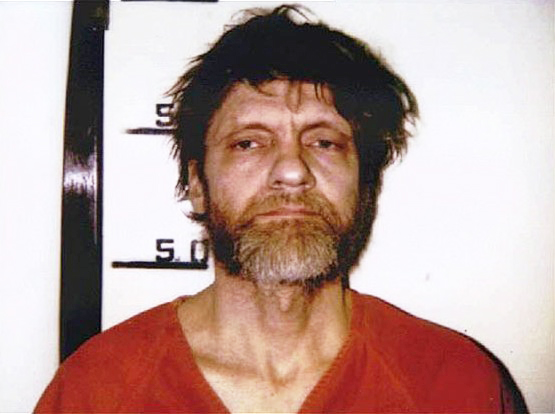
The University and Airline Bomber, or as deemed by the media – Unabomber, severely injured nearly two dozen people, and caused the painful deaths of three individuals. He had the FBI wildly, and fruitlessly, chasing him for nearly 17 years, and the public shaking in fear for the same amount of time.
Yet, according to him, he only did these heinous acts to warn the public, to spread his manifesto, claiming in it that technology is the doom of man, it seems that he was the doom in this case.
Who’s the face behind the killings?

Theodore John Kaczynski, born May 1942; a genius, with an IQ of over 160; a child prodigy, that managed to get into Harvard on a scholarship at just age 16; a devoted mathematician and professor; a killer.
Ted became a devotee of primitive life and believed that society and nature alike are both cursed to suffer at the hands of technological evolution, the suffering that already started with the Industrial Revolution as stated in his Manifesto “The Industrial Revolution and its consequences have been a disaster for the human race”. The bomber claimed that this technology is taking away our freedom and human nature, replacing it with a need to surrender to machines.
Harvard, the place of nightmares.
Kaczynski entered Harvard as an anxiety stricken, naive 16-year-old with an aversion to his peers, as most didn’t consider him an equal that deserved respect. He was a good and devoted student that tried his hardest to appease to societal norms but struggled immensely when it came to any form of relationships, whether be it romantic or platonic.
It would be during his second year at Harvard when he stumbled into something that would change him forever.
Henry Murray was a psychologist at Harvard that didn’t care about morality, more just about getting answers. His goal was to study the psychology of distress and the general reaction to the stress of students by exposing them to harsh treatment of verbal abuse and humiliation. Specifically, he ordered his subjects to write papers detailing their viewpoints and beliefs, before having authority figures scrutinize, laugh at, and harshly criticize their writing.
The psychologist filmed these encounters, especially the reactions of his human guinea pigs, and then repeatedly showed the subjects the footage of both the attack, as well as their response to the attack, over the course of three years. That was at least how one Theodore Kaczynski was treated throughout his second, third and fourth year at Harvard University.
How did the experiments change the participants?
Criticism, particularly harsh one that borders on verbal abuse, is a form of “discipline” used by both stricter parents and even stricter bosses as a way to elicit behavioural changes has been proven time and time again to do more bad than good. Although harsh criticism does change a humans behaviour, it changes it for the worse, as there are two ways people deal with verbal abuse; either submit to it, which in turn lowers their self-esteem and over a long period of time can make a person more reclusive, introverted and shy; or fight it, which at first may work, but the longer the abuse lasts the more aggressive does the victim become.
Connecting this back to the Unabomber, it is clear that his values and beliefs were challenged and although at first, it may have seemed that the experiments did not do any damage, in the long run, this is what could have been what caused Kaczynski to turn to such violent methods of spreading his word.
As doctor Steven Stosny stated in his article What’s wrong with criticism?
“If you want resistance, criticise.”, the Unabomber’s actions can be easily interpreted as a form of resistance against those who don’t have the same views as he does.
As well as that, even though Kaczynski states otherwise, his attacks on Universities could have been a subconscious need to retaliate on those who hurt him.
Rough childhood and it’s permanent consequences.

In this new environment, his peers developed a distaste for him, as he was younger but smarter, as one of his classmates described “He was never really seen as a person, as an individual personality … He was always regarded as a walking brain, so to speak”. Then the bullying started which caused him to become even more excluded from his peers. Even though, the bullying stopped when he transferred to university, the emotional gap between Ted and his peers continued growing. Most who interacted with him knew him as being intellectual but lonely.
The Unabomber’s mental health problems.
Things didn’t start looking up for the Unabomber in his early 20’s as that was about the time his schizophrenia had developed. Schizophrenia is a genetic mental disorder, where the one suffering can have various symptoms such as hallucinations or paranoia during a psychotic episode.
It is theorized by some, such as Theodore’s own brother – David, that it was his untreated schizophrenia that led him to commit these crimes as he states in an interview with Duke University Press that he is “reluctant to blame Ted’s violence on Murray, Harvard, and the CIA”.
According to NIH, schizophrenia can cause a person to seem as if they have lost touch with reality, so it is understandable as to why it may seem as if his mental illness caused his violence.
Was Kaczynski delusional?

While this theory can not be fully disproven, especially due to Kaczynski’s supposed anosognosia – the belief of a person with a disability, either mental or physical, that they do not have said disability – it is highly unlikely, as people during either psychosis or psychotic breaks are usually frantic and chaotic, with a lot of them forgetting to do things as simple as eating or sleeping. Not only that but one of the “types” of schizophrenic symptoms are cognitive symptoms, which cause problems with attention, concentration, and memory.
The bombings were too organized, too carefully planned to have been the results of delusion Kaczynski might have suffered.
In conclusion, I do wholeheartedly believe that the abuse that Kaczynski suffered at the Harvard experiments were the main ingredient in the creation of the Unabomber. That, of course, does not mean that his childhood traumas and early adulthood schizophrenia weren’t partly to blame but it is important to note that traumas and mental disorders do not create killers, it’s the conditions around them that can make them snap.
Hanna Lech, MYP2(ic)
Projekt został wykonany w ramach szkolnego programu tutoringowego.